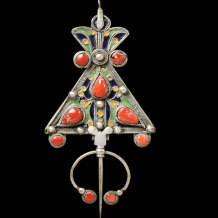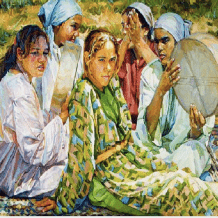
Tin Mal is 100 km from Marrakech just past the village of Ijoukak on the road to Taroudant in the High Atlas Mountains. It was the spiritual home of the Almohads, who went on to conquer Marrakech defeating the ruling Almoravids and then creating an empire that stretched from all of what we know as the Maghreb, southern Portugal, and Spain and part of Africa.
It began when Ibn Toumert of the Masmoudi tribe established the mosque at Tin Mal with a fortified town, called a ribat, in 1122. He proclaimed himself the Mahdi and established a strict and puritanical rule over his followers. All you see today is the imposing mosque that was rebuilt by Ibn Toumert’s successor, Abd el Mumin who went on to take Marrakech in 1148. It has been recently restored. It is one of only two mosques that non- Muslims can enter in Morocco, the other being the Hassan II Mosque in Casablanca.

The mosque is high up in a striking position over looking the river N’Fis andbears witness to the fervour of the Almohads with high walls and strong towers. It has been recently renovated and is one of the most memorable sites of historical significance in Morocco. There is a small museum housing architectural fragments. The mosque maybe closed on Fridays when the villagers of Tin Mal come to pray. In former times the mosque would have covered in white plaster and true to its founder’s puritanical ideals is free from the decorative features normally found in Moroccan mosques.
The prototype for Tin Mal was the Great Mosque at Taza (near Fès), also built by Abd el Mumin. The Koutoubia at Marrakech (the Almohad capital as of 1148) was in turn modeled on it. Tin Mal was the starting point of the Almohad dynasty which lasted till 1269. In 1276 the Merindes stormed Tin Mal leaving only the mosque standing killing the entire population. It remained the heartland of the Almohads and its rulers would come in pilgrimage to visit the tombs of their predecessors and pray at the mosque. It is a place to soak up the atmosphere of a movement and dynasty which saw the beginning of Morocco we know today.
Further on from Ijoukak,Tagountafte, Souk Lara and Ikhfe N’Boul is the remains of the kasbah of the once-powerful caid of the Goundafa tribe. The Gandoufa vied with the Glaoua and the M’Touga tribes for control of the Atlas Mountains at the end of the 19th century. The Gandoufa Kasbahs which are now in ruins controlled the entry to the valley. Si Taieb Gandoufa succeded as caid in 1883 and fought other tribes with his army of 5,000 tribes men to increase his territory. In 1906 rival tribes plundered the N’fis valley and burned his Kasbah, Talat –n-Yakoub, whilst the caid was away in Fes.
However, in 1912 the Kasbahs of Azemmour and Aguergour were returned to him and the French gave him money and weapons to conquer the Sous valley. He captured Taraoudannt in 1913 and was appointed Pasha of Tiznit. He retired to his mountain kasbahs in 1924 where he died at the age of 65. The French left it to leaders like Si Taieb Gandoufa and Thami al Glaoui Pasha of Marrakech to secure the south of Morocco during the protectorate and the ruins of their Kasbahs are their memorial and the relics of the last bastions of feudalism in Morocco.
For more information about visiting Tin Mal & The Gandoufa Valley Marrakech






